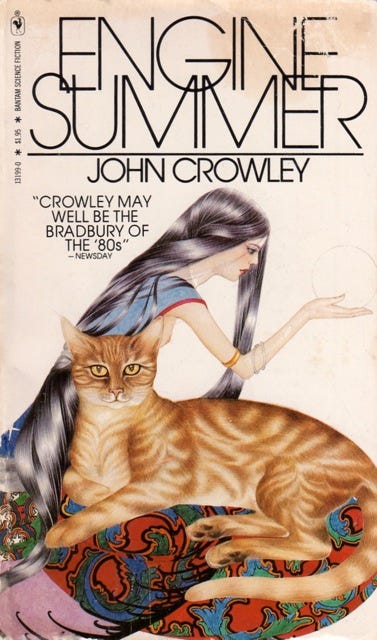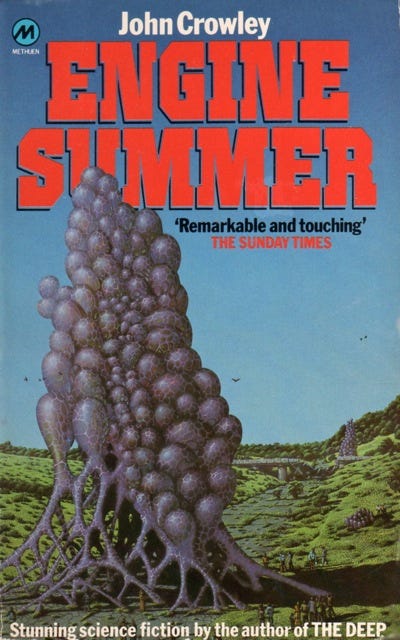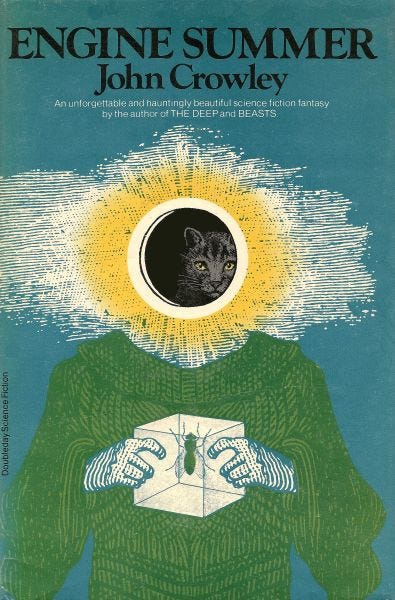John Crowley: Engine Summer (1979)
When Rush That Speaks is fourteen years old he leaves his home community of Little Belaire in search of he’s not quite sure what. In part, he is on a general quest to find “lost things”. In part, he wants to become a “saint”. In part he is searching for a girl, Once A Day, who left several years before. He walks out through the woods, and enters a larger world.
Beyond the fact that it a post-collapse America in about a thousand years’ time, it is difficult to summarise the world of Engine Summer. This is not only apt but I suspect in some sense deliberate, since the novel thematises this very problem, the hermeneutic circle not merely of a “text” but of a life or a world. It is not necessary to elicit “post-modernism” here, we need only note that this is a story about stories, what they are to us and how they function for us. The protagonist struggles to make sense of his life and his world, and so does the reader, though for the reader the process is a joy.
Rush That Speaks is trying to deliver the story of his short life, and sometimes despairs of being able to:
How am I to tell you all of this? How? In order to tell you any single thing I must tell you everything first; every story depends on all the stories being known beforehand.
You can tell it; it can be told. Isn’t that what it is to be a saint? To tell all stories in the single story of your own life?
A “saint” in the society Rush was raised in is not a Christian saint but rather someone who tells their own life so truthfully, so “transparently”, that other people see their own lives in this story, and so remember it and pass it on. A saint is a storyteller and a story at once. In Rush’s community all the stories they tell each other are supposed to be true – there is no fence between secular and sacred tales. History, religion and literature are not separate categories in Little Belaire.
The collapse that separates our world from the world of the novel is known as “the Storm”, and is never described in detail. In contrast with many “post-apocalyptic” stories which protest against nuclear war or climate change, the collapse is not what the story of Engine Summer is about. In his synopsis for an early version of Engine Summer, then titled Learning to Live With It, Crowley envisions this collapse as gradual and intermittent rather than sudden and catastrophic. Civilisation overreached, things went wrong, and eventually the lights went out. Rush’s world is what is left: a kind of pastoral Arcadia, in which people live peacefully among the ruins of a more ambitious, restless society. This is a reversed Golden Age in that it is the latest rather than the earliest age, begging the question as to which age has priority. It is a Romantic, belated pastoral, and necessarily bittersweet.

Where the old civilisation overreached, this new society risks underreaching. Its communities are shrinking, thanks in part to a modification made to the species long ago which prevents women from becoming pregnant unless a specific drug is taken. The drug is still manufactured, but it’s a precarious situation. Meanwhile the scattered, backward-looking “avvengers” (scavengers, avengers), ideological descendants of American libertarianism who idolise the pre-Storm world and who are held in contempt by the tranquil, matriarchal tribes (and by many reviewers of the book) may have a brighter future due to their longstanding obsession with finding women who can reproduce without the drug. The avvenger Rush meets, Teeplee, has many children, while the children of Little Belaire tend to be only children, as Rush is. There is an implied historical cycle here, a pendulum swinging from male striving to female dwelling and back again. Crowley invokes the yin-yang symbol in his synopsis, and the book may be shaped as a yin-yang, the interdependence and “interpenetration” (a word used several times within it) of seeming opposites.
The book is full of interpenetrating dichotomies. Rush’s journey takes him from one community to another seemingly opposite one. The culture of his home, the community of Little Belaire, is centred on the stories of the saints, and each of these stories has a “proof” to go with it, an artefact kept in one of many chests and which the “gossips” (wise-women and lore-keepers) produce as a matter of course when they recite the legends. Everyone who grows up in Little Belaire is taught to be a “truthful speaker”, which seems to be a method of speaking which communicates one’s inner state, a fuller and more transparent way of talking with others. They value transparency above all, which they ultimately envision as something akin to what Yeats called “Unity of Being”. As the gossip Painted Red, Rush’s teacher, tells Rush when he’s a child:
“In transparent life, the saints hoped that one day we might be free from death: not immortal, as the angels tried to become, but free from death, our lives transparent even as we live them: not through a means, you see, like the Filing System or even truthful speaking, but transparent in their circumstances: so that instead of telling a story that makes a life transparent, we will ourselves be transparent, and not hear or remember a saint’s life, but live it: live many lives in the moment between birth and dying.”
“How could that come about?” I said, unable to grasp it, or even imagine it.
“Well,” she said, “If I knew, perhaps I would be a great saint.”
Rush’s adventures lead him to Dr. Boots’s List, another peaceful, matriarchal community, but one with an apparently opposite ideal: not transparency, but opacity. When Rush, a truthful speaker, first encounters them they seem to him to be wearing masks, but he comes slowly to understand that this is not a surface opacity that conceals something, but rather an opacity that runs deep. Their cult is centred on the receipt of “letters” from the mysterious Dr. Boots. When Rush manages to get himself initiated into their mysteries, he finds that this “letter” is delivered by a functioning machine from before the Storm which is able to temporarily transfer a stored personality into a living person’s body. A transparent globe is activated, turns opaque, and fits itself over one’s head; then one is momentarily inhabited by Dr. Boots, the only surviving personality imprint. Dr. Boots’s message comes into being on receipt, its meaning in search of a recipient, a meaning which is created between the sender and the receiver - like a letter.
The imprint of Dr. Boots was produced, Rush learns later, to test the process: Dr. Boots was not the inventor of the machine - she was a cat. The List is a cat cult, there are cats everywhere, and this is why. Once a year each member is ceremonially invaded by the psychology of a cat.
They should have seemed childlike, the List, with their changeable sadnesses and enthusiasms, their dark and light, their endless, pointless small bickerings. But they weren’t childlike; they seemed old—not aged, but like grownups, with histories, with old knowledge, old manners, a careful, circumspect way—and how could that be, I wondered, that they could change like children and play like kittens, that yesterday and tomorrow could be real for them only as a dream is real, and yet seem circumspect?
Their goal is to eliminate past and future, to live in a perpetual present, free of history and striving, like a cat. When Rush himself gets a letter from Dr. Boots it is the strangest passage in the book, as he struggles to interpret the world around him as though he’s experiencing it for the first time. He resorts to circumlocutions which resemble the tortured prose of Hegel or Heidegger:
And I—I was nothing; but when Zhinsinura said that, “open your eyes,” I uncurled outward from some tiny center of not-being and built Rush to receive it: the path those words took and the place the path led through spun out both together. The words watched me watch myself make a place that held a path which the words took through the place to where I built it.
Clearly Rush is bumping up against the limits of language - an opacity.
Yet while these two communities, the transparent, memory-preserving Little Belaire and the opaque, deliberately forgetful List, are opposite in certain ways, they interpenetrate as well, like yin and yang. They trade, for one thing. It is the List that still produces “medicine’s daughter”, the drug which allows the conception of children. In exchange, Little Belaire provides “St. Bea’s bread”, a strange alien plant which provides nutrition when smoked. It is during one such trading session that little Once A Day leaves her family and Rush behind to join the cat cult.
But they also share certain qualities. The calm inwardness of Little Belaire mirrors the calm inwardness of the List, and is fuelled in part by their lifelong daily consumption of St. Bea’s bread, a plant brought to earth by a pre-Storm space project, which alters them just as the letters from Dr. Boots alter members of the List. And the List has an old calendar, a spot of memory within their life of quasi-Zen forgetfulness, with which they mark off the days and months just as the “angels” (pre-Storm people, like us) used to do. As one of the List puts it to Rush:
“This is the riddle: you can tie a string around your finger to remember something, until you forget there’s a string tied around your finger. Then you will have forgotten doubly, and for good. This calendar is the string tied around our finger—and the letter from Dr. Boots is how we forget it, doubly and for good.

The greater part of the prose in Engine Summer is clear with an achieved clarity, which is needed, because the story is dense with meaning. There are explicit riddles, so to speak, like the riddle of the string around the finger; but there are many hidden riddles as well. Crowley’s art is intricate, almost miniature: everything rhymes with something else, and no sentence is wasted. Images repeat in variations, accruing meaning as Rush’s spirit expands to contain multitudes.
The characters often understand the world around them in terms of metaphor, and the metaphors are often so suggestive that they spark off three more metaphors in later conversations. Almost at random, here is another of Painted Red’s lessons:
“A life […] is circumstances. Circumstances are encirclings, they’re circles. The circle of a saint’s life, all its circumstances, is contained in the story of his life as he tells it; and the story of his life is contained in our remembering it. The story of his life is a circumstance in ours. So the circle of his life is contained in the circle of our lives, like circles of ripples rising in water.”
The outermost circular ripple would be the oldest and earliest made, and the ripples within it younger, so the the metaphor reverses what it represents: our new lives contain the older lives of the saints. This suggests that the saints are forever younger than us. (“We may return to Mozart,” Wallace Stevens wrote, “For he was young, and we, we are old.”) And when the sphere which holds Dr. Boots’s imprint is placed over Rush’s head, that sphere contains the sphere of his skull as he comes to contain Dr. Boots.
These rhymes and echoes and parallels criss-cross the book, not in a confusing flux but in an intricate design. You can ponder them endlessly, in part because they form a beautiful, poetic structure, and in part because Crowley gets at fundamental questions about our narrative species. When you read or hear a story, do you contain it, or does it contain you? Not for nothing does Crowley take his epigraph from Kafka’s “On Parables”.

Although Engine Summer is in many ways identifiably a science fiction novel, set as it is in a post-collapse future America, its world bears little resemblance to that of Wells or Asimov - or even to the “science fantasy” worlds of Jack Vance and his followers. Rather, it is a world adjacent to those of Lewis Carroll or Vladimir Nabokov. The Nabokov who claimed that “great novels are great fairy-tales” is Crowley’s avowed master, while various elements from Carroll’s Alice books are alluded to both in Engine Summer and Crowley’s next work, the widely celebrated Little, Big.
When Rush That Speaks asks how he can tell his story, he is told, roughly as the White Rabbit is told by the King of Hearts, to “Begin at the beginning; go on till you reach the end. Then stop.” There are the twins Budding and Blooming, who are a benign version of Tweedledum and Tweedledee. There are the continual experiences with psychoactive substances, taken in a spirit equal parts utilitarian and exploratory, which alter Rush and/or reality in ways that recall Alice’s adventures rather more than, say, the druggy Beat writers. Rush eats something to make time vanish; he smokes something that allows him to hibernate through winter. It is more dreamlike than psychedelic, more Carroll-esque than dreamlike.
And most intriguing of all of the Alice parallels is Rush’s experience in the forest around the List’s encampment, which parallels Alice’s time in the Wood Where Things Have No Names. Alice encounters a fawn, but because they have both forgotten what they are called they don’t know how to recognise one another, and only after they emerge from the wood does the fawn remember that he is a fawn and Alice is a human, and so bounds away in terror. Rush is passed in the dark nighttime woods by what he assumes is some large animal, and only later realises that it was the girl he has been searching for and hasn’t seen since they were ten years old, Once A Day.
How huge the world is, and how few in it, and she passed me in the darkness in the forest and I hadn’t known. […] But this is not she, I thought; the girl I had known had not had breasts, her dark aureoles were like small closed mouths, like unopened buds. This one’s thick hair was black, and her eyes startlingly blue, her down-turned eyebrows made an angry sulk; but it wasn’t she. Six springs had passed; there was a light beard on my face. I wasn’t I.
The influence of Carroll and Nabokov is audible occasionally in the prose itself. Crowley is, as is generally recognised, an exquisite stylist, and even when his sentences betray or indeed show off their influences they remain fit objects of intense envy:
The way people revolve back into the crowded warm interior of the warren in winter is matched by the way they come out as it gets warm again, slowly, the old ones staying in wrapped up till late in the spring, but the kids running out before the snow melts and catching crocuses and colds.
But beyond the stylistic resemblances (“catching crocuses and colds”), Crowley seems to have learned from Carroll and Nabokov to approach words with an apparently childlike freshness – a childlike sophistication like that of Alice, who sees through the merely childish, obtuse pretensions of the adult world, the arbiters of which she dismisses as nothing but a pack of cards.
In the world Crowley portrays, words like “saint,” “engine”, “angel” and “gossip” take on new meanings, meanings which at first seem radically different from the usual meanings of these words, but which the reader gradually perceives to be enlightening inflections of the normal definitions. This is speculative writing of the highest and most imaginative kind.

Rush’s interlocutor in the frame narrative, in a sense his interrogator, is an “angel”, which is what Rush’s people call us, i.e. pre-collapse people living in a high-tech world. This “angel” lives in the floating city of Laputa where the tech still works and the records are still kept. Rush’s world, the surface world, is prehistoric in the sense that they have no written records. We gradually realise through the course of the book that Rush is not actually in the floating city – his personality has been imprinted, and is ceremonially experienced by the inhabitants in a similar way to the List with Dr. Boots. Crowley beautifully lets the reader figure out that unlike Dr. Boots’s sphere, which becomes opaque when activated, Rush’s sphere remains transparent. They are parallel opposites, the full and dark of the moon.
And we learn, in a truly remarkable twist, that Rush’s account of his life changes depending on whose body he is inhabiting, which is to say that the whole narrative is tinged with the personality of someone besides Rush about whom we know next to nothing, not even his name. We know only that Rush’s host and his interlocutor love one-another, which inflects everything else we hear. It’s a tremendously suggestive play on the old Conradian or Nabokovian unreliable narrator. We are told the truth (because Rush is a “truthful speaker”) but we can’t be sure how much of this truth is Rush’s and how much his host’s, just as we can’t be sure how much of the truth of any story we read is the author’s and how much of it is our own. Crowley elaborates these mysteries without reducing them to mere answers. His riddles are their own answers, and resonate.
Every detail of the book can be interrogated for meanings. Why is the protagonist called Rush That Speaks? Because he’s in a rush, leaving home very young, as he tells us. Because truths speak through him like wind in rushes. Once A Day’s name has a sexual connotation, as she is Rush’s love interest, but she is also drawn to the List who seek to experience each day, each moment, as all-in-all. Then there is a medical connotation, a medicine to be taken once a day, and in Engine Summer there is no hard boundary between medication and intoxicants, as she intoxicates Rush while also bringing him healthfully out of himself. And so on.
Then there is the title of the book. Engine Summer is a play on “Indian summer”, an American phrase meaning a period of relatively calm and warm weather in late autumn - the belated Golden Age of a post-collapse world. The word “engine” in Little Belaire refers to any of the angels’ contraptions, so it means “machine”, but reminds us also that the English word “engine” is cognate not only with “ingenuity” but also “genius”. Rush’s story is being dictated through the engine in which his personality and memories have been imprinted, and his story is powered by the engines of time and human nature, as well as Crowley’s imagination, his genius. An engine summer might be an ingenious pastoral tale, such as this book, which is clearly a work of genius. It’s a book to read and reread for a lifetime.





